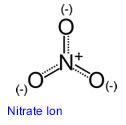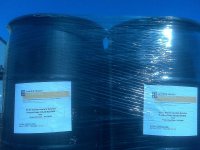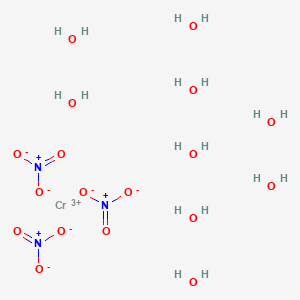SECTION 1. IDENTIFICATION
Product Name: Chromium Nitrate Solution
Product Number: All applicable American Elements product codes, e.g. CR-NAT-02-SOL
, CR-NAT-03-SOL
, CR-NAT-04-SOL
, CR-NAT-05-SOL
CAS #: 7789-02-8
Relevant identified uses of the substance: Scientific research and development
Supplier details:
American Elements
10884 Weyburn Ave.
Los Angeles, CA 90024
Tel: +1 310-208-0551
Fax: +1 310-208-0351
Emergency telephone number:
Domestic, North America: +1 800-424-9300
International: +1 703-527-3887
SECTION 2. HAZARDS IDENTIFICATION
Emergency Overview OSHA
Hazards
Carcinogen, Irritant
GHS Classification
Oxidizing liquids(Category 2)
Skin corrosion(Category 1)
Serious eye damage(Category 1)
Specific target organ toxicity-single exposure(Category 3)
Acute aquatic toxicity(Category 3)
GHS Label elements, including precautionary statements
Pictogram
Signal word
Danger
Hazard statement(s)
H272May intensify fire; oxidizer.
H314 Causes severe skin burns and eye damage.
H335 May cause respiratory irritation.
H402 Harmful to aquatic life.
Precautionary statement(s)
P220 Keep/Store away from clothing/ combustible materials.
P261 Avoid breathing dust/ fume/ gas/ mist/ vapors/ spray.
P280 Wear protective gloves/protective clothing/eye protection/ face protection.
P305+P351+P338 IF IN EYES: Rinse cautiously with water for several minutes. Remove contact
lenses, if present and easy to do. Continue rinsing.
P310 Immediately call a POISON CENTER or doctor/ physician.
HMIS Classification
Health hazard: 2
Chronic Health Hazard :*
Flammability: 0
Physical hazards: 0
Personal protection F
NFPA Rating
Health hazard: 2
Fire: 0
Reactivity Hazard: 0
Potential Health Effects
Inhalation
May be harmful if inhaled. Causes respiratory tract irritation.
Skin
May be harmful if absorbed through skin. Causes skin irritation.
Eyes
Causes severe eye burns. Causes eye irritation.
Ingestion
May be harmful if swallowed.
SECTION 3. COMPOSITION/INFORMATION ON INGREDIENTS
Chromium trinitrate
13548-38-4
Ox. Liq. 2; Skin Irrit. 2; Eye Irrit. 2; STOT SE 3; H272, H315, H319, H335 30-50%
SECTION 4. FIRST AID MEASURES
Description of first aid measures
General advice
Move out of dangerous area.
Consult a physician. Show this safety data sheet to the doctor in attendance.
If inhaled
If breathed in, move person into fresh air. If not breathing, give artificial respiration. Consult a physician.
In case of skin contact
Wash off with soap and plenty of water. Consult a physician.
In case of eye contact
Rinse thoroughly with plenty of
water for at least 15 minutes and consult a physician.
If swallowed
Never give anything by mouth to an unconscious person. Rinse mouth with water. Consult a physician.
SECTION 5. FIREFIGHTING MEASURES
Extinguishing media
Suitable extinguishing media
Use water spray, alcohol-resistant foam, dry chemical or carbon dioxide.
Special hazards arising from the substance or mixture
Nitrogen oxides (NOx), Chromium oxides
Advice for firefighters
Wear self-contained breathing apparatus for firefighting if necessary.
Further information
Use water spray to cool unopened containers.
SECTION 6. ACCIDENTAL RELEASE MEASURES
Personal precautions, protective equipment and emergency procedures
Use personal protective equipment. Avoid dust formation. Avoid breathing vapors, mist or gas. Ensure adequate ventilation. Evacuate personnel to safe areas. Avoid breathing dust.
For personal protection see section 8.
Environmental precautions
Do not let product enter drains.
Methods and materials for containment and cleaning up
Sweep up and shovel. Contain spillage, and then collect with an electrically protected vacuum cleaner or by wet-brushing and place in container for disposal according to local regulations (see section 13). Keep in suitable, closed containers for disposal.
Reference to other sections
For disposal see section 13.
SECTION 7. HANDLING AND STORAGE
Precautions for safe handling
Avoid contact with skin and eyes. Avoid formation of dust and aerosols.
Further processing of solid materials may result in the formation of combustible dusts. The potential for combustible dust formation should be taken into consideration before additional processing occurs.
Provide appropriate exhaust ventilation at places where dust is formed.Keep away from sources of ignition -No smoking.Keep away from heat and sources of ignition.
For precautions see section 2.
Conditions for safe storage, including any incompatibilities
Keep container tightly closed in a dry and well-ventilated place.
Storage class (TRGS 510): Oxidizing hazardous materials
SECTION 8. EXPOSURE CONTROLS/PERSONAL PROTECTION
Exposure controls
Appropriate engineering controls
Handle in accordance with good industrial hygiene and safety practice. Wash hands before breaks and at the end of workday.
Personal protective equipment
Eye/face protection
Safety glasses with side-shields conforming to EN166 Use equipment for eye protection tested and approved under appropriate government standards such as NIOSH (US) or EN 166(EU).
Skin protection
Handle with gloves. Gloves must be inspected prior to use. Use proper glove removal technique (without touching glove's outer surface) to avoid skin contact with this product. Dispose of contaminated gloves after use in accordance with applicable laws and good laboratory practices. Wash and dry hands.
Body Protection
impervious clothing, The type of protective equipment must be selected according to the concentration and amount of the dangerous substance at the specific workplace.
Respiratory protection
Where risk assessment shows air-purifying respirators are appropriate use a full-face particle respirator type N100 (US) or type P3 (EN 143) respirator cartridges as a backup to engineering controls. If the respirator is the sole means of protection, use a full-face supplied air respirator. Use respirators and components tested and approved under appropriate government standards such as NIOSH (US) or CEN (EU).
Control of environmental exposure
Do not let product enter drains.
SECTION 9. PHYSICAL AND CHEMICAL PROPERTIES
Information on basic physical and chemical properties
Appearance
Form: Liquid
Odor
No data available
Odor Threshold
No data available
pH
1.0 -3.0
Melting point/freezing point
Melting point/range: no data available
Initial boiling point and boiling range
No data available
Flash point
N/A
Evaporation rate
No data available
Flammability (solid, gas)
No data available
Upper/lower flammability or explosive limits
No data available
Density
1.5
Vapor pressure
No data available
Vapor density
No data available
Relative density
No data available
Water solubility
No data available
Partition coefficient: n-octanol/water
No data available
Auto-ignition temperature
No data available
Decomposition temperature
No data available
Viscosity
No data available
Explosive properties
No data available
SECTION 10. STABILITY AND REACTIVITY
Reactivity
No data available
Chemical stability
Stable under recommended storage conditions.
Possibility of hazardous reactions
No data available
Conditions to avoid
No data available
Materials to avoid
Organic materials, Powdered metals
Hazardous decomposition products
Other decomposition products-
nitrogen oxides, chromium oxides
In the event of fire: see section 5
SECTION 11. TOXICOLOGICAL INFORMATION
Information on toxicological effects
Acute toxicity LD50
Oral-Rat-3,250 mg/kg
Inhalation: No data available
Dermal: No data available
No data available
Skin corrosion/irritation
No data available
Serious eye damage/eye irritation
No data available
Respiratory or skin sensitisation
No data available
Germ cell mutagenicity
Human
fibroblast
DNA inhibition
Hamster
ovary
Cytogenetic analysis
Hamster
ovary
Sister chromatid exchange
Carcinogenicity
This product is or contains a component that is not classifiable as to its carcinogenicity based on its IARC, ACGIH, NTP, or EPA classification.
IARC:
3-Group 3: Not classifiable as to its carcinogenicity to humans(Chromium trinitrate)
NTP:
No component of this product present at levels greater than or equal to 0.1% is identified as a
known or anticipated carcinogen by NTP.
OSHA:
No component of this product present at levels greater than or equal to 0.1% is identified as a
carcinogen or potential carcinogen by OSHA.
Reproductive toxicity
No data available
No data available
Specific target organ toxicity -single exposure
No data available
Specific target organ toxicity -repeated exposure
No data available
Aspiration hazard
No data available
Additional Information
RTECS: GB6300000
Stomach-Irregularities-Based on Human Evidence
Stomach-Irregularities-Based on Human Evidence
SECTION 12. ECOLOGICAL INFORMATION
Toxicity
No data available
Persistence and degradability:
No data available
Bioaccumulative potential:
No data available
Mobility in soil:
No data available
Results of PBT and vPvB assessment:
PBT/vPvB assessment not available as chemical safety assessment not required/not conducted
Other adverse effects
An environmental hazard cannot be excluded in the event of unprofessional handling or disposal. Harmful to aquatic life.
SECTION 13. DISPOSAL CONSIDERATIONS
Waste treatment methods
Product
Burn in a chemical incinerator equipped with an afterburner and scrubber but exert extra care in igniting as this material is highly flammable.
Offer surplus and non-recyclable solutions to a licensed disposal company.
Contact a licensed professional waste disposal service to dispose of this material.
Contaminated packaging
Dispose of as unused product.
SECTION 14. TRANSPORT INFORMATION
DOT (US)
UN number: 2720
Class: 5.1
Packing group: III
Proper shipping name: Chromium nitrate
Reportable Quantity (RQ):
Poison Inhalation Hazard: No
IMDG
UN number: 2720
Class: 5.1
Packing group: III
EMS-No: F-A, S-Q
Proper shipping name: CHROMIUM NITRATE
IATA
UN number: 2720
Class: 5.1
Packing group: III
Proper shipping name: Chromium nitrate
SECTION 15. REGULATORY INFORMATION
SARA 302 Components
No chemicals in this material are subject to the reporting requirements of
SARA Title III, Section 302.
SARA 313 Components
The following components are subject to reporting levels established by SARA Title III, Section 313:
Chromium trinitrate
CAS-No.
7789-02-8
Revision Date
2007-03-01
SARA 311/312 Hazards
Reactivity Hazard, Chronic Health Hazard
Massachusetts Right To Know Components
No components are subject to the Massachusetts Right to Know Act.
Pennsylvania Right To Know Components
Chromium trinitrate
CAS-No.
7789-02-8
Revision Date
2007-03-01
New Jersey Right To Know Components
Chromium trinitrate
CAS-No.
7789-02-8
Revision Date
2007-03-01
California Prop. 65 Components
This product does not contain any chemicals known to State of California to cause cancer, birth defects, or any other reproductive harm.
SECTION 16. OTHER INFORMATION
Safety Data Sheet according to Regulation (EC) No. 1907/2006 (REACH). The above information is believed to be correct but does not purport to be all inclusive and shall be used only as a guide. The information in this document is based on the present state of our knowledge and is applicable to the product with regard to appropriate safety precautions. It does not represent any guarantee of the properties of the product. American Elements shall not be held liable for any damage resulting from handling or from contact with the above product. See reverse side of invoice or packing slip for additional terms and conditions of sale. COPYRIGHT 1997-2022 AMERICAN ELEMENTS. LICENSED GRANTED TO MAKE UNLIMITED PAPER COPIES FOR INTERNAL USE ONLY.

 materials. American Elements can prepare dissolved homogeneous solutions at customer specified concentrations or to the maximum stoichiometric concentration. Packaging is available in 55 gallon drums, smaller units and larger liquid totes. American Elements maintains
materials. American Elements can prepare dissolved homogeneous solutions at customer specified concentrations or to the maximum stoichiometric concentration. Packaging is available in 55 gallon drums, smaller units and larger liquid totes. American Elements maintains  The number of electrons in each of Chromium's shells is 2, 8, 13, 1 and its electron configuration is [Ar] 3d5 4s1. Louis Nicolas Vauquelin first discovered chromium in 1797 and first isolated it the following year. The chromium atom has a radius of 128 pm and a Van der Waals radius of 189 pm. In its elemental form, chromium has a lustrous steel-gray appearance.
The number of electrons in each of Chromium's shells is 2, 8, 13, 1 and its electron configuration is [Ar] 3d5 4s1. Louis Nicolas Vauquelin first discovered chromium in 1797 and first isolated it the following year. The chromium atom has a radius of 128 pm and a Van der Waals radius of 189 pm. In its elemental form, chromium has a lustrous steel-gray appearance.  Chromium is the hardest
Chromium is the hardest 
